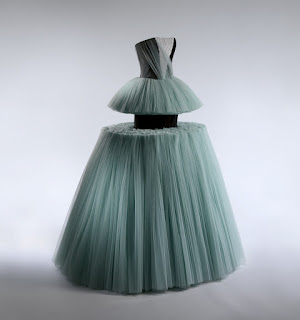 |
| Ball Gown, Viktor & Rolf spring/summer 2010 |
The Costume Institute's fall 2016 exhibition, MASTERWORKS: Unpacking Fashion features significant acquisitions of the past 10 years and explores how the department has honed its collecting strategy to amass masterworks of the highest aesthetic and technical quality, including iconic works by designer who have changed the course of fashion history and advanced fashion as an art form The exhibition runs through February 5, 2017. Image: Self-proclaimed "fashion artists" Viktor & Rolf celebrates their distinct brand with this blue polyester tulle and black silk-synthetic moire embroidered with white plastic sequins from their "Credit Crunch Couture" collection. The striking sculptural form subverts the tradition of a feminine 1950's-style dress bisecting densely stitched clouds of tulle with a flourish intended to evoke the swipe of a chainsaw.
 |
| Maison Margiela ensemble with Red Coat 1787-92 |
 |
| Heidi Slimane spring/summer 2014 |
A selection of Charles James structured ball gowns draws attention as do numerous examples of creations by contemporary designers including Yohji Yamamoto, Alexander McQueen and Comme des Garcons.
Yves Saint Laurent's scandalous 1971 "Liberation" collection featured signature elements of 1940's fashion. (right)The dress at center with a print of bright red lips against a black background belongs to the ready-to-wear interpretation of the collection. (left) In 2014 Yves Saint Laurent creative director Heidi Slimane revived the iconic motif in a white silk crepe blouse, embroidered with lip motifs in white iridescent and red plastic sequins and black glass beads, trousers black wool gabardine.
The exhibition is a fascinating If the holidays prove too hectic for you, take this option. The exhibition is featured om the Museum's website, as well as on Facebook, Instagram and Twitter using #FashionMasterworks.
Ta Ta Darlings!!! Fan mail is always welcome at pollytalknyc@gmail.com. Visit Polly's Blogs at www.pollytalk.com and click in the left hand column to Blogs on visionary men, women determined to succeed, poetry from the heart.



